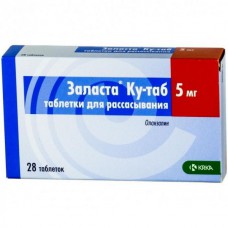Expiration date: 09/2026
Structure and Composition
Zalasta tablets
1 tablet contains olanzapine 5 mg and 10,
Excipients: Cellactose (a spray-dried compound consisting of 75% alpha-lactose monohydrate and 25% cellulose powder), pregelatinized starch, corn starch, colloidal anhydrous silica, magnesium stearate, in a package 28 pcs.
pharmachologic effect
Zalasta has antipsychotic, neuroleptic action.
testimony
schizophrenia (treatment)
Zalasta effectively supports the improvement of clinical symptoms during long-term treatment of patients with initial positive response to the drug.
moderate or severe episodes of mania (treatment)
prevention of relapse of mania in bipolar disorder patients with manic episodes with good effect of olanzapine therapy.
Contraindications
Hypersensitivity to olanzapine or to other components of the drug,
angle-closure glaucoma,
rare hereditary problems of galactose intolerance, Lapp lactase deficiency or malabsorption of glucose-galactose,
lactation,
Children up to age 18 years (effectiveness and safety have been established).
Precautions: renal failure, liver failure, prostatic hyperplasia, paralytic ileus, epilepsy, convulsions in history, leukopenia and / or neutropenia of various origins, myelosuppression of various origins, including myeloproliferative disorders, hypereosinophilic syndrome, cardiovascular and cerebrovascular disease, or other conditions predisposing to hypotension, inherent increase in the QT interval on an electrocardiogram (increasing corrected interval QT (the QTc) on the ECG), or under the conditions with the potential to cause an increase in the QT interval (eg co-administration of drugs prolonging the QT interval, congestive heart failure, hypokalemia, hypomagnesemia), advanced age, and concomitant use of other drugs of the central action, immobilization, pregnancy.
Pregnancy and breast-feeding
Due to the limited experience of the drug in pregnant women, olanzapine should be used only if the expected benefit to the mother justifies the potential risk to the fetus. Women should be informed of the need to inform your doctor about the ensuing or planned pregnancy with olanzapine treatment. There are few reports of tremor, hypertension, lethargy and sleepiness in children born to mothers treated with olanzapine in the III trimester of pregnancy. The study revealed that olanzapine is released in breast milk. Average dose (mg / kg) received by the child when the equilibrium concentration of the mother, was 1.8% of the dose of olanzapine mother (mg / kg). We do not recommend breastfeeding on the background of treatment with olanzapine.
Dosing and Administration
Inside, regardless of the meal - 5-20 mg / day. In schizophrenia in adults recommended initial dose - 10 mg / day. In acute mania associated with bipolar disorder in adults - 15 mg / day (1x) alone or 10 mg / day (1 time) in combination with drugs Li + or valproic acid (maintenance therapy at the same dose). When depression associated with bipolar disorder in adults - 5 mg / day (1 time) in combination with 20 mg of fluoxetine (alteration drug doses permitted if necessary). Elderly patients, patients with risk factors (including severe chronic renal failure or hepatic insufficiency of moderate severity), with a combination of risk factors (female gender, geriatric age, non-smoking), which may slow the metabolism of olanzapine recommended initial dose reduction to 5 mg / d.
Side effects
Frequency: Very frequent (10%), frequent (more than 10% and less than 1%), rare (less than 1% and more than 0.1%), rare (less than 0.1% and more than 0.01%), very rarely (less than 0.01%) . In clinical studies, very often observed drowsiness and weight gain in 34% - hyperprolactinemia (weakly expressed and transient). Clinical manifestations of hyperprolactinemia were rare. Common: dizziness, asthenia, akathisia, appetite increase, peripheral edema, orthostatic hypotension, dryness of the oral mucosa, constipation. Rare: transient, asymptomatic increase of ALT, AST. In rare cases, the rise in plasma glucose greater than 200 mg / dl (suspected diabetes), 160-200 mg / dl (suspected hyperglycemia) in patients with an initial concentration of glucose of less than 140mg / dl. Instances increase of triglyceride (at 20 mg / dL from baseline), cholesterol (0.4 mg / dL from baseline), asymptomatic eosinophilia (sporadic cases). Patients with psychosis on dementia: very often - disturbance of gait and falling, often - urinary incontinence and pneumonia. Patients with psychosis induced by taking a dopamine agonist in Parkinson's disease: very often - increased Parkinsonian symptoms and hallucinations. In patients with bipolar mania (receiving the drug in combination with drugs Li + or valproic acid): very often - increased body weight, dryness of the oral mucosa, increased appetite, tremor, often - a speech disorder. The following are the side effects observed in clinical trials and post-marketing experience of application. From the CCC: often - orthostatic hypotension, rarely - bradycardia, rarely - venous thromboembolism. From the digestive system: often - constipation, dryness of the oral mucosa, increased appetite, rarely - hepatitis, rarely - pancreatitis, jaundice. On the part of metabolism: often - peripheral edema, very rarely - diabetic coma, diabetic ketoacidosis, hyperglycemia, hypercholesterolemia, hypertriglyceridemia. From the musculoskeletal system: very rarely - rhabdomyolysis. From the nervous system: very often - drowsiness, often - akathisia, dizziness, fatigue, rarely - seizures. For the skin: rarely - rash. From the urogenital system: very rarely - priapism. From the side of hematopoiesis: often - eosinophilia, rarely - leukopenia, rarely - thrombocytopenia. Laboratory findings: very often - hyperprolactinemia often - increasing the activity of ALT, AST, hyperglycemia, very rarely - hyperbilirubinemia, increased alkaline phosphatase activity. Other: very often - increased body weight, rarely - photosensitivity, very rarely - allergic reactions, syndrome.
special instructions
In the treatment with neuroleptics (in t.ch.olanzapinom) may develop neuroleptic malignant syndrome (hyperthermia, muscle rigidity, altered mental status, autonomic disorders, including the unstable pulse or blood pressure, tachycardia, cardiac arrhythmias, increased sweating, increased activity of CK , myoglobinuria as a result of rhabdomyolysis, acute renal failure). In identifying the clinical manifestations of neuroleptic malignant syndrome (including hyperthermia without others. Symptoms) requires removal of olanzapine. With the development of symptoms of tardive dyskinesia recommended dose reduction or withdrawal of olanzapine. The symptoms of tardive dyskinesia can grow or manifest after discontinuation of the drug. When receiving olanzapine (research) in elderly patients with psychosis were observed on dementia cerebrovascular disorders (stroke, transient ischemic attack), including fatalities. These patients had preexisting risk factors (cerebrovascular disorders (history), transient ischemic attack, hypertension, smoking), and related diseases and / or receiving drugs by the time associated with cerebrovascular disorders. Olanzapine is not recommended for the treatment of patients with psychosis on dementia. Special caution is required when increasing the activity of ALT and / or AST in patients with hepatic insufficiency or receiving treatment for a potentially hepatotoxic drugs. Observation of the patient is required and, if necessary, a dose reduction. It noted a higher prevalence of diabetes mellitus in patients with schizophrenia. Very rarely, there have been cases of hyperglycemia of diabetes or worsening of pre-existing diabetes mellitus, ketoacidosis and diabetic coma. Not established a causal relationship between antipsychotic drugs and these states. It is recommended clinical monitoring of patients with diabetes mellitus or with risk factors for its development. Olanzapine should be used with caution in patients with a history of seizures, or in the presence of factors that reduce the seizure threshold. Olanzapine should be used with caution in patients with a reduction in the number of white blood cells and / or neutrophils, with signs of depression or toxic disorders of the bone marrow under the influence of drugs (in history), with the suppression of bone marrow function due to concomitant disease, radio- or chemotherapy (in history ) with hypereosinophilia or myeloproliferative disease. The use of olanzapine in patients with neutropenia or agranulocytosis klozapinzavisimoy (in history) was not associated with recurrence of these violations. It is recommended to exercise caution in the appointment of olanzapine in patients with prostatic hypertrophy with clinical manifestations, paralytic ileus, narrow-angle glaucoma. Olanzapine exhibits antagonism against dopamine and, in theory, can inhibit the effect of levodopa and dopamine agonists. Caution should be exercised when olanzapine in combination with others. Centrally acting drugs and ethanol. During the period of treatment must be careful when driving and occupations potentially hazardous activities that require high concentration and psychomotor speed reactions.
Interaction
Inducers or inhibitors of CYP1A2 isoenzyme may alter the metabolism of olanzapine. Clearance of olanzapine is increased in smokers and patients with concomitant use of carbamazepine (increased CYP1A2 activity). Ethanol did not affect the pharmacokinetics of olanzapine in the equilibrium state, however, the reception of ethanol, together with olanzapine may be associated with increased pharmacological effects of olanzapine (sedation). Activated charcoal reduces the bioavailability of olanzapine to 50-60%. Fluoxetine (60 mg once daily or 60 mg daily for 8 days) increases Cmax of olanzapine by 16% and decreases clearance by 16%, which has no clinical significance (olanzapine dose adjustment is not required). Fluvoxamine (CYP1A2 inhibitor) reducing the clearance of olanzapine, olanzapine Cmax increases in non-smoking women at 54% and 77% - in male smokers, the AUC - 52% and 108%, respectively (olanzapine dose reduction is necessary). Olanzapine significantly suppresses the formation of valproic acid glucuronide (major route of metabolism). Valproic acid has little effect on the metabolism of olanzapine. No clinically significant pharmacokinetic interaction between olanzapine and valproate is unlikely.
Overdose
Symptoms: very common (> 10% ,,) - tachycardia, agitation / aggression, dysarthria, various extrapyramidal symptoms, decreased level of consciousness by lethargy to coma, less than 2% of cases - delirium, convulsions, coma, neuroleptic malignant syndrome (NMS ), respiratory depression, aspiration, increased or decreased blood pressure, cardiac arrhythmia, in rare cases - cardio-pulmonary insufficiency. The minimum dose of olanzapine in acute overdose fatalities - 450 mg, registered a maximum dose of an overdose of a favorable outcome (survival) - 1500 mg.
Treatment: gastric lavage, activated carbon (reduces the bioavailability of olanzapine by 60%), symptomatic treatment under the control of vital functions, including the treatment of arterial and vascular collapse gapotenzii, maintaining respiratory function. There is no specific antidote. It is not recommended to induce vomiting, to apply epinephrine, dopamine, or other beta-sympathomimetics Adrenomimeticalkie activity as the latter may worsen hypotension. To detect possible arrhythmias requires monitoring of cardiovascular activity. The patient should be under continuous medical supervision until complete recovery.
Storage conditions
The temperature is not above 25 ° C.
Shelf life - 5 years.



